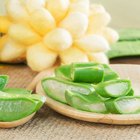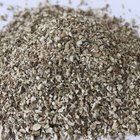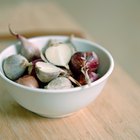
Okrugnosti/iStock/Getty Images
Acne is a skin condition that affects approximately 80 percent of Americans between the ages of 12 and 40. Acne is caused when the skin becomes inflamed due to the sebaceous glands becoming blocked. As this condition worsens, ducts leading to the glands harden, with the areas exposed to air filling with dirt and causing what we know as blackheads. When the secretion is so deep that air and dirt cannot reach the ducts, whiteheads form. With acne, the skin can become rough and red where the ducts are blocked, causing irritation. Acne can be caused by a variety of factors such as oily skin, hormonal imbalances, stress, allergies, eating too much junk food, nutritional deficiencies, use of certain cosmetics, hormones and exposure to industrial toxins. It is also a condition that is often inherited.
Red Clover
Known in Latin as Trifolium pratense, red clover is also called trefoil, purple clover, wild clover, cleaver grass and cow grass. Originating in Europe and Asia, red clover is found in the United States and is the state flower of Vermont. The plant is a perennial with long stalks, hairy stems, smooth leaves divided into three parts and reddish purple flowers. It is the flowers that yield the most medicinal potency for healing skin disorders such as acne. Native Americans have used red clover for skin conditions and body purification for centuries, understanding how powerful its properties are for cleansing the system of toxins.
What Red Clover Does
Red clover is known to purify the bloodstream of toxins that can adversely affect the skin, often leading to acne. It does this by cleansing the liver, the primary organ responsible for blockages that can lead to a plethora of physical problems. When the liver is not able to function properly, impurities get into the bloodstream, where they affect most of our organs. Red clover functions as a diuretic, helping to produce urine whereby impurities such as uric acid can then be flushed out thought the kidneys and bladder. Because it is an anti-inflammatory, the plant helps to discharge phlegm and mucus from the chest and lungs. Encouraging bile production, which is also essential in liver cleansing, it also stimulates the digestive fluids, helping with elimination that contributes to clearer, healthier skin.
What Red Clover Contains
Red clover is an excellent tonic for the entire body, as it contains a wide range of necessary nutrients. Some of these elements include isoflavones, coumarins, flavinoids, lecithin, calcium, chromium, choline, magnesium, manganese, iron and vitamins B, C and E. Red clover also contains a trance element called molybdenum, which helps to eliminate nitrogenous waste that can cause skin problems.
How to Take Red Clover
Red clover can be eaten in salads or as a addition to honey, which helps to enhance its flavor. It is important to buy organic red clover, as this avoids the possibility of ingesting pesticides or other hazardous elements that may be sprayed on the plant. Red clover can also be found in tea form, in capsules and as a tincture. It is always best to consult with a health expert to determine the proper amount to use, as well as the best method of ingestion.
Word to the Wise
Speaking with your health-care provider will also help you avoid any possible counter-indications, especially if you are taking specific medications that may interact with the plant. For some people, red clover can cause nausea or stomach upset, so be sure to get an OK from a trusted professional when using the plant to treat your skin condition.
Related Articles

Pycnogenol and Acne

Burdock Root for Acne

Arnica for Acne

Does Milk Thistle Help Skin?

What Are the Benefits of Ashwagandha in ...

Benefits of Vitamin C for Facial Pores

Burt's Bees Ingredient List

Can Bag Balm Help Acne?

Anise Seed Cautions and Side Effects

Vitamins for Mental Alertness

What Is Aloe Good For?

Golden Flax Seed Vs. Dark Flax Seed

Ingredients of Accutane

Dandelion Root for Reduced Acne Symptoms

Uses of Peptides

Can You Eat the Green Stem of a ...

Chamomile & Aloe Skin Care

How to Whiten the Eye

Which Foods Help You Get Toxic Waste ...

Aloe Vera Gel As a Wrinkle Reducer
References
Writer Bio
Michele Kadison has been writing professionally for more than 25 years. Her blog, The Body in Form, focuses on vitality, balance and wellness as a way of life. Other publications include Next2Eden, Chefs Without Frontiers, Rockies Travel and more. Kadison has a Bachelor of Arts in writing from Hamilton College.
Photo Credits
Okrugnosti/iStock/Getty Images